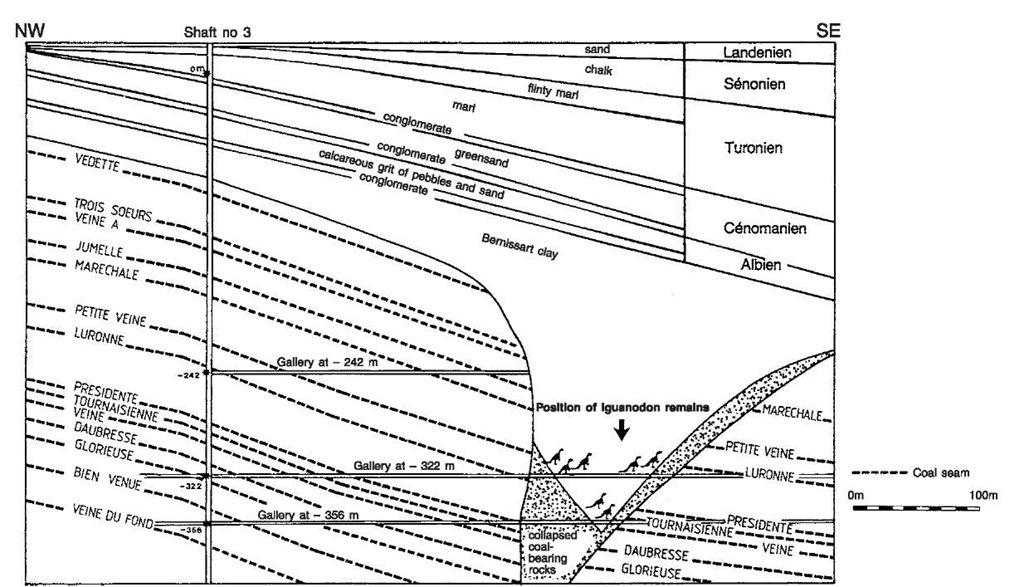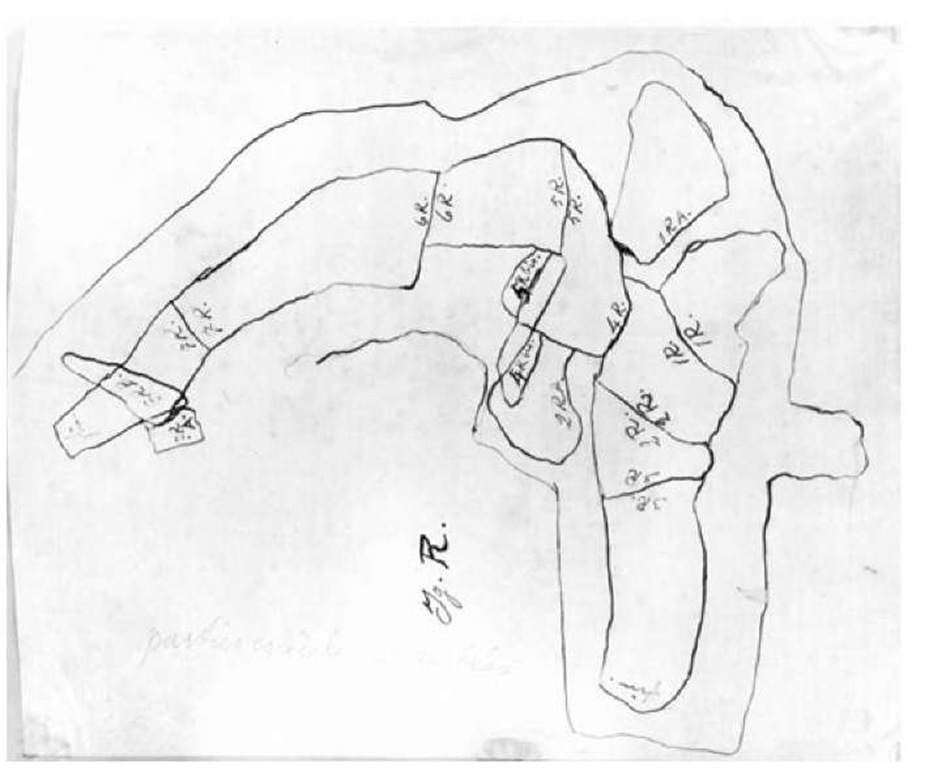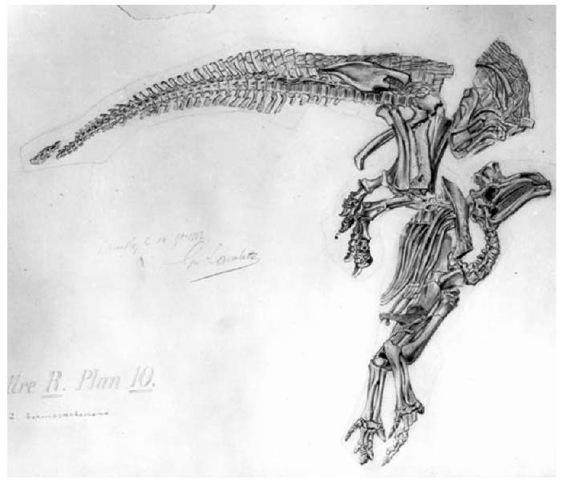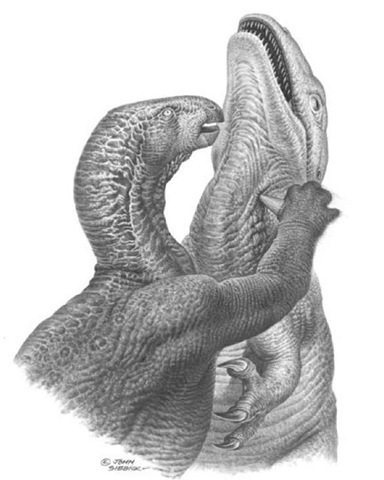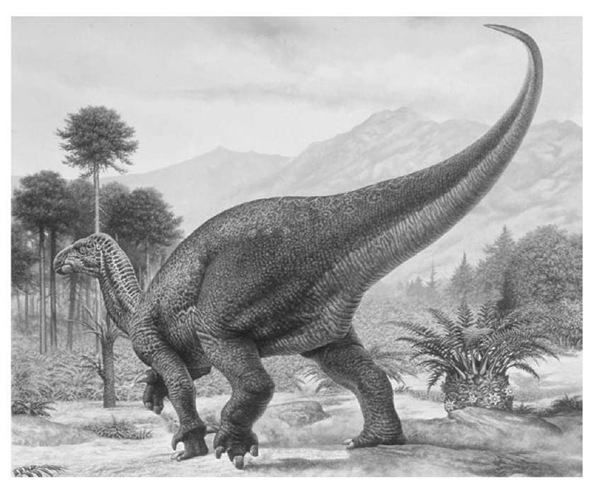The resurgence in palaeobiology in the 1960s, and the new insights into dinosaurs prompted by John Ostrom’s important work, provided a spur to reinvestigate some of the earliest discoveries.
Louis Dollo’s description of the incredible discoveries of Iguanodon at Bernissart created the image of a giant (5 metres tall, 11 metres long) kangaroo-like creature. It had:
Powerful back legs and a massive tail that helped it to balance … [and] was a plant eater … it grasped bunches ofleaves with its long tongue, then pulled them into its mouth to be clipped off with the beak.
The picture of Iguanodon was of an animal that was the dinosaur equivalent of a ‘tree browser’, represented in the recent past by the giant South American ground sloths and today by giraffes. Dollo himself referred to Iguanodon as a ‘girafe reptilienne’. Rather surprisingly, nearly every aspect of this vision of Iguanodon is incorrect or seriously misleading.
Bernissart: a ravine where Iguanodon perished?
Some of the earliest work at Bernissart focused on the extraordinary circumstances of the original discovery. The dinosaurs had been unearthed in a coal mine at depths of between 356 and 322 metres below the surface (Figure 18). This was unexpected, as the coal seams being excavated were known to be Palaeozoic in age and dinosaurs are of course unknown in rocks of such antiquity. However, the Iguanodon skeletons were not found in the coal seams themselves, but in a pocket of shale of Cretaceous age that cut across the more ancient coal-bearing rocks. Mining geologists had a commercial interest in discovering the extent of these clays, and the degree to which they might affect coal extraction, so they began mapping the area.
Cross sections of the mine, created during these geological investigations, suggested that the horizontal layers of Palaeozoic rocks (with their valuable coal seams) were occasionally cut through very steeply by beds of Mesozoic shale (finely laminated clays). The cross sections gave the first impression of steep-sided ravines cut into the ancient rocks, and formed the basis for a graphic and rather appealing notion that the Bernissart dinosaurs represented a herd that had tumbled to their deaths (Figure 18). Dollo, himself no geologist, was more inclined to the idea that these dinosaurs had lived, and died, in a narrow gorge. However, the more dramatic story had the greater impact, and was further embellished by suggestions that they had been stampeded into the ravine by huge predatory dinosaurs (megalosaurs), or by some freak event such as a forest fire. This was not entirely wishful thinking: extremely rare fragments of a large predatory dinosaur were discovered within the Iguanodon-bearing beds; and charcoal-like lumps of coal were recovered from some of the rubble-like deposits found in the region between the coal-bearing rocks and the dinosaur-bearing shaly beds.
The discoveries at Bernissart presented a huge logistic challenge in the 1870s and early 1880s. Complete skeletons of dinosaurs measuring up to 11 metres in length had been discovered at the bottom of a deep mine; they were the focus of worldwide interest at the time, but how were they to be excavated and studied?
18. Geological section of the Bernissart mine
A cooperative venture was arranged between the Belgian government, funding the scientists and technicians of the Royal Natural History Museum in Brussels, and the miners and engineers at the colliery in Bernissart. Each skeleton was carefully exposed and its position in the mine recorded systematically on plan diagrams. Every skeleton was divided into manageable blocks approximately 1 metre square. Each block, protected by a jacket of plaster of Paris, was carefully numbered and recorded on plan drawings (Figure 19) before being lifted and transported to Brussels.
Back in Brussels, the blocks were reassembled from the records, rather like a gigantic jigsaw puzzle. The plaster was painstakingly removed to reveal the bones of each skeleton. At this point an artist, Gustave Lavalette, specially commissioned for the project, drew the skeleton in its death pose before any further preparation or extraction was undertaken (Figure 20). Some skeletons were completely extracted from the shale and mounted to create a magnificent display that can be seen to this day at the (renamed) Royal Institute of Natural Sciences, in Pare Leopold, Brussels. Other skeletons were cleared of the shale matrix on one side only and arranged in their burial pose on wooden scaffolding supporting vast banks of plaster. This display mimics their entombed positions when they were first discovered in the mine at Bernissart.
19. Plan diagram of an excavated Iguanodon skeleton from Bernissart
The original plans of each excavation, and some crude geological sections and sketches of the discoveries, are preserved in the archives of the Royal Institute in Brussels. This information has been ‘mined’, this time for clues concerning the geological nature of the dinosaur burial site.
The geology of the coal-mining area of the Mons Basin, in which lies the village of Bernissart, had been the subject of study before dinosaurs were ever discovered. A major review in 1870 pointed out that the coal-bearing strata of the Mons Basin were pock-marked by ‘cran’ (naturally formed subterranean pits). Each ‘cran’ was of limited extent and filled with shales. It was concluded that these had formed by the dissolution of Palaeozoic rocks deep underground. The roofs of such caverns collapse periodically under the sheer weight of the overlying rocks, so the spaces become filled with whatever lies above: in this case soft clays or shales. The collapse of such sediments had been recorded locally in the Mons area as rather alarming, earthquake-like shocks. By amazing coincidence, a minor ‘earthquake’ of this type took place while the dinosaurs were being excavated in August 1878 at Bernissart. Minor collapses in the galleries were noted, as well as flooding, but the miners and scientists were soon able to resume their work once the flood water had been pumped out.
20. Lavalette’s drawing of the Iguanodon skeleton seen in Figure 19
Despite all the local geological knowledge, it is very curious that the scientists from the Museum in Brussels incorrectly interpreted the geological nature of the ‘cran’ at Bernissart. The mining engineers produced crude geological sections from the tunnels that yielded the dinosaurs. These showed that immediately beyond the coal-bearing seams there was a section of 10-11 metres of breccia (broken beds containing irregular blocks of limestone and coal mixed with silt and clay, the ‘collapsed coal-bearing rocks’ of Figure 18) before entering steeply dipping, but more regularly stratified, shales that yielded the fossils. Toward the middle of the ‘cran’ the clay beds were horizontally bedded, and as the tunnel approached the opposite side of the ‘cran’ the beds once again became steeply tilted in the opposite direction before passing again into a brecciated region and finally re-entering the coal-bearing deposits. The symmetry of the geology across the ‘cran’ is exactly what would be expected if overlying sediments had slumped into a large cavity.
The sediments in which the dinosaurs are embedded also directly contradict the ravine or river-valley interpretations. Finely stratified shales containing the fossils are normally deposited in low-energy, relatively shallow-water environments, probably equivalent to a large lake or lagoon. There is simply no evidence for catastrophic deaths caused by herds of animals plunging into a ravine. In fact, the dinosaur skeletons were found in separate layers of sediment (along with fish, crocodiles, turtles, thousands of leaf impressions, and even rare insect fragments), proving that they definitely did not all die at the same time and therefore could never have been part of a single herd of animals.
Study of the orientation of the fossil skeletons within the mine suggests that dinosaur carcasses were washed into the burial area on separate occasions and from different directions. It was as if the direction of flow of the river that carried their carcasses had changed from time to time, exactly as happens in large, slow-moving river systems today.
So, as early as the 1870s, it was clearly understood that there were neither ‘ravines’ nor ‘river valleys’ in which the dinosaurs at Bernissart might have perished. It is fascinating how the dramatic discovery of dinosaurs at Bernissart seems to have demanded an equally dramatic explanation for their deaths, and that such fantasies were uncritically adopted even though they flew in the face of the scientific evidence available at the time.
The image of Iguanodon as a gigantic kangaroo-style creature has become iconic because of the generous distribution of full-sized skeletal casts to many museums around the world. But does the evidence for this restoration survive further scrutiny?
A ‘twist’ in the tail
Re-examining the skeletal evidence from first principles, the anatomy of the skeletons from Bernissart reveal some disconcerting features. One of the most obvious concerns the massive tail of Iguanodon. The well-known reconstruction shows the animal (Figure 12) propped, in true kangaroo style, using its tail and hind legs tripod-like. To adopt this posture, the tail curves upward to the hip. In sharp contrast, all the documentary and fossil evidence points to this animal normally holding its tail essentially straight or somewhat downwardly curved. This is clearly seen in the specimens arranged on banks of plaster in the museum, and in the wonderful pencil sketches made of their skeletons before they were exhibited (Figure 20). It could of course be argued that this shape was simply an artefact of preservation, but this explanation is definitely not plausible here. The backbone was in effect ‘trussed’ on either side by a trellis-like arrangement of long bony tendons that held the backbone quite deliberately straight; these can be seen in Figure 20. As a result, the heavy, muscled tail served as an enormous cantilever to balance the weight of the front part of the body at the hips. The truth is that the upward sweep of the tail seen in Dollo’s reconstructions would have been physically impossible for these animals in life. Careful examination of the skeleton revealed that the tail was deliberately broken in several places to achieve the upward bend – a case perhaps of Louis Dollo making the skeleton fit his personal ideas a little over-zealously.
This discovery disturbs the pose of the remainder of the skeleton. If the tail is straightened so that it can adopt a more ‘natural’ shape, then the tilt of the body changes dramatically, with the backbone becoming more horizontal and balanced at the hip. As a result the chest is lower, bringing the arms and hands closer to the ground and raising questions about their likely function.
Hands or feet?
The hand of Iguanodon has become part of dinosaurian folklore for one obvious reason. The conical thumb-spike was originally identified as a rhinoceros-like horn on the nose of the Iguanodon (Figure 9) and was immortalized in the giant concrete models erected at London’s Crystal Palace (Figure 2, topic 1). It was not until Dollo provided the first definitive reconstruction of Iguanodon in 1882 that it was proved to everyone’s satisfaction that this bone was indeed a part of the dinosaur’s hand. However, the hand (and the entire forelimb) of this dinosaur held a few more surprises.
The thumb, or first finger, comprises a large, conical, claw-bearing bone that sticks up at right angles to the rest of the hand and can be moved very little (Figure 21A). The second, third, and fourth fingers are very differently arranged: three long bones (metacarpals) form the palm of the hand and are bound tightly together by strong ligaments; the fingers are jointed to the ends of these metacarpals and are short, stubby, and end in flattened and blunt hooves. When these bones were manipulated, to see what their true range of movement was likely to be, it was found that the fingers splayed outwards (away from each other) and certainly could not flex to form a fist and perform simple grasping functions, as might have been expected. This distinctive arrangement looks similar to that seen in the feet of this animal: the three central toes of each foot are similarly shaped and jointed, splay apart, and end in flattened hooves. The fifth finger is different from all the others: it is quite separate from the previous four and set at a wide angle from the remainder of the hand; it is also long and has a wide range of movement at each joint, and was presumably unusually flexible.
This re-examination led me to dramatically revise earlier ideas and conclude that the hand is one of the most peculiar seen in the entire animal kingdom. The thumb was without doubt an impressive, stiletto-like weapon of defence (Figure 21B); the three central fingers were clearly adapted to bear weight (rather than for grasping things as hands usually do); and the fifth finger was sufficiently long and flexible to act as a truly finger-like grasping (prehensile) organ (Figure 21A).
The idea that the hand could act as a foot for walking upon, or at least supporting some of the body weight, was revolutionary – but was it true? This prompted further research on the arm and shoulder for additional evidence that might confirm such a radical reinterpretation.
21A. Iguanodon’s hand, showing a range of uses
First of all, the wrist proved to be interesting. The bones of the wrist are welded together to form a bony block, instead of being a row of smooth, rounded bones that could slide past one another in order to allow that hand to swivel against the forearm. All the individual wrist bones have been welded together by bony cement, and are further strengthened around the outside by strands of bony ligament. These features obviously combined to lock the wrist firmly against the hand and forearm bones and resist the forces acting through them during weight-bearing, as would be necessary if the hands were truly acting as feet.
21B. The stiletto-like thumb of Iguanodon in action
The remainder of the arm bones are extremely stoutly built, again primarily for strength during weight support, rather than for allowing flexibility as is more normal with genuine arms. The stiffness of the forearm has important consequences for the way in which the hand would have been placed on the ground – the fingers would have pointed outward and the palms inward – an unusual consequence of converting a hand into a foot. The pose of the hand, in this rather awkward manner, has been confirmed by examination of the shape of forefoot prints left by this dinosaur.
The upper arm (humerus) is massive, rather pillar-like, and shows evidence that it anchored huge arm and shoulder muscles. This is also unusually long, over three-quarters the length of the hind limb. The true size of the arms is somewhat masked in the original skeletal reconstructions, because they were folded against the chest and always seemed shorter than they really are.
22. New reconstruction of Iguanodon
Finally, the shoulder bones are large and powerfully built, which makes perfect sense if the arms are functioning as legs. But the shoulders show another unexpected feature. In the centre of the chest of the larger skeletons at Bernissart there is an irregular bone that grew in the soft tissues across the centre of the chest between the shoulder joints. This bone is pathological in origin – it formed as a response to strain within the chest created while the animal was walking on all fours (and is called an intersternal ossification).
Reassessing the posture of Iguanodon in the light of these observations, it seems clear that a more natural pose of the backbone was horizontal, with the body weight distributed along the backbone and largely balanced at the hips and supported by the massive and strong hind legs. The ossified tendons distributed along the spine, above the chest, hip, and tail, clearly acted as tensioners to distribute body weight along the backbone. This pose allowed the front limbs to reach the ground, and these were used for weight support while these animals were stationary. Iguanodon probably moved slowly on all fours at least part of the time (Figure 22).
